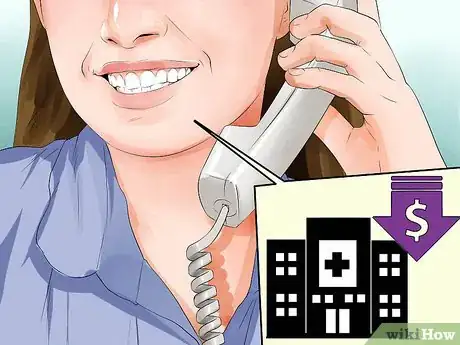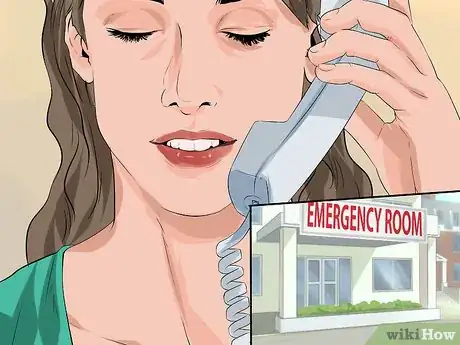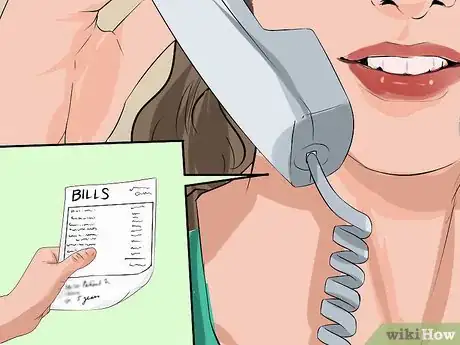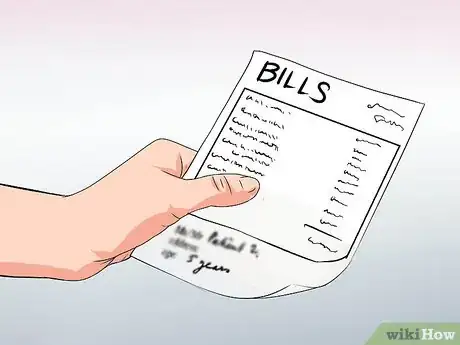wikiHow is a “wiki,” similar to Wikipedia, which means that many of our articles are co-written by multiple authors. To create this article, 11 people, some anonymous, worked to edit and improve it over time.
There are 8 references cited in this article, which can be found at the bottom of the page.
This article has been viewed 112,724 times.
Learn more...
Emergency room visits to the hospital can leave a patient with grave financial injuries after treatment is complete. Although most hospitals cannot legally refuse to treat a patient in need of care, they still have the right to aggressively collect fees resulting from the visit. Whether you have health insurance or not, always scrutinize your bill for inaccurate and inflated charges. You may also be able to negotiate with the hospital to find a way to pay your bill.
Steps
Planning Ahead
-
1Know where you're covered. Choosing the right hospital can make all the difference. Do your research before you need to go to the emergency room so you will know exactly where to go when an emergency happens.[1]
- If you have insurance, make sure you know which hospitals are considered in-network and which are considered out-of-network. Your bill will likely be much lower if you choose an in-network facility.
- If you do not have insurance, contact the hospitals in your area to see if any of them offer discounts to uninsured patients. You may even be able to find a facility that offers up-front cash prices, so there won't be any surprises.
-
2Start saving. Even if you have insurance, your copayment and deductible may be very high for an emergency room visit.[2] If possible, set aside some money for emergencies little by little.
- If you have access to a flexible spending account through work, this is a great way to pay for medical expenses. You can generally deposit up to $2850/year into your account, and you won't have to pay income taxes on this money.[3]
- If you don't have access to a flexible spending account, consider opening a savings account at your bank to use as an emergency fund. Setting up automatic transfers from your checking account to you savings account might make it easier to get in the habit of putting money away.
Advertisement -
3Decide if you need to go to the emergency room. You should never avoid going to the emergency room for financial reasons during a true emergency. Depending on the situation, however, the emergency room might not be the best choice. Choosing a doctor's office or urgent care facility over an emergency room for appropriate conditions can save you thousands.[4]
- If you do not need immediate treatment for your condition, consider scheduling an appointment with a doctor.
- If you need immediate care, but your condition is not serious or life-threatening, consider an urgent care facility.
- If there is any danger whatsoever that your condition may be serious, it is best to visit the emergency room.
-
4Verify coverage. If you end up going to the emergency room, verify that the hospital is included in your insurance plan if possible. You may want to call your insurance company's service center if you are not sure if the hospital is in-network.
- Provide your insurance information during the emergency room visit. If you have insurance, your policy will be billed. Whether you are insured or lack coverage, usually you won't be asked to pay anything upfront. Bills arrive later.
- Confirm that the hospital will not charge you anything upfront. Most hospitals will not deny you help because of your inability to pay.
Dealing With Unreasonable Charges
-
1Request an audit from the facility. Contact the emergency room medical care providers that sent the bill and tell their billing departments that you are requesting an account audit to look for billing errors. Facilities don't perform this service unless a patient asks for one.
- Inform the representative that you will be investigating the bills and will not send payment until you confirm the accuracy of every charge.
-
2Hire an outside company to perform an audit. A medical billing professional may be able to locate errors in your bill, such as coding mistakes, duplicate charges, or overcharges.
-
3Review all emergency room bills yourself. Document any unnecessary charges you find on paper or in a spreadsheet. Then contact the facilities that sent you the bill to discuss the charges.[5]
- Look for inflated prices such as overpriced bandages. Compare and document hospital charges for those items against their retail cost in a pharmacy.
- Ensure that you received all of the treatments listed on the bill.
-
4Appeal insurance decisions. If you have been denied coverage, exercise your right to Challenge an HMO's Denial of Coverage.
-
5Wait for all revised bills to arrive. No matter how you identified inaccurate charges, you should receive an updated bill. Review the charges and the amount you owe for accuracy.
- Be sure to explain to the facility that you will not pay anything until the correct bills are sent. Doing so can indicate that you agree to the original charges.
Getting Assistance With Your Bill
-
1Ask for a payment plan. If you cannot afford to pay the entire bill, you may be able to arrange to make monthly payments. Most facilities will not charge interest rates on balances due if payments are arranged and made on time.[6]
- Do not send partial payments without arranging an installment plan with the medical facility. Doing so may put your account in default status.
-
2Request a reduction. Some hospitals may be willing to negotiate your bill, especially if you do not have insurance.[7]
- Document your financial situation. Discuss why you want a reduction in your bill and then ask for the facilities to negotiate lower rates.
- You may be able to support your argument for a lower rate if you can find out how much insurance companies are billed for the same services you received. This amount is often less than the amount uninsured patients are billed.[8]
-
3Get a patient advocate. You may be able to find a nonprofit to help you, or you can consider hiring a firm that will charge you a percentage of your savings to help you reduce your bill.[9]
-
4Ask the hospital for a list of charities. If you still cannot afford to make payments, some charities will help patients pay for the emergency room.[10]
- Locate your financial information such as completed tax forms. Charities will need to verify your inability to pay.
References
- ↑ https://www.debt.org/medical/emergency-room-urgent-care-costs/
- ↑ https://www.medicare.gov/coverage/emergency-department-services
- ↑ https://www.healthcare.gov/flexible-spending-accounts/
- ↑ https://www.nlm.nih.gov/medlineplus/ency/patientinstructions/000593.htm
- ↑ https://www.cnbc.com/2020/10/28/you-can-negotiate-your-medical-bills-heres-how-to-lower-your-costs.html
- ↑ https://www.cnbc.com/2020/10/28/you-can-negotiate-your-medical-bills-heres-how-to-lower-your-costs.html
- ↑ https://www.cnbc.com/2020/10/28/you-can-negotiate-your-medical-bills-heres-how-to-lower-your-costs.html
- ↑ http://money.usnews.com/money/blogs/my-money/2012/08/16/10-ways-to-deal-with-an-expensive-emergency-room-bill
- ↑ https://library.nclc.org/guide-reducing-hospital-bills-lower-income-patients































































Medical Disclaimer
The content of this article is not intended to be a substitute for professional medical advice, examination, diagnosis, or treatment. You should always contact your doctor or other qualified healthcare professional before starting, changing, or stopping any kind of health treatment.
Read More...